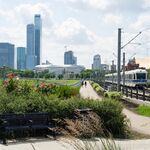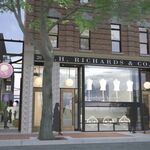You are using an out of date browser. It may not display this or other websites correctly.
You should upgrade or use an alternative browser.
You should upgrade or use an alternative browser.
Downtown Real Estate
- Thread starter Daveography
- Start date
BIGE
New Member
Keep dreaming haha. Has Alldritt even opened the sales center yet?
archited
Senior Member
How did you guess (or did someone tell you) that my middle name is "Spicy" and, btb, "threw" not "through".@archited Oooooh I like that last one you through in there, keepin it spicy!
A project that is going to take 5 years to build does not need to rush to put in place a "sales center" and how did you guess (or did someone tell you) that my middle name is "Dreaming" -- my mother apparently thought that it was better than "stickinthemudinsidetheboxthinking" btw I have two --2-- middle names. In toto: Tedward Spicy Dreaming Powellinskichuck.Keep dreaming haha. Has Alldritt even opened the sales center yet?
BIGE
New Member
How long would the detailed design on a building like Alldritt take?
IanO
Superstar
8-12 months I'd wager for the entire process of CD, DD, CD
They had plans to open a sales centre (I've seen the plans) on the adjacent lot and it was to have been up a year ago, but given the market conditions, lack of investor buyers and impact of competitor product delivery (along with many other financing and constructibility factors), it has not occurred.
They had plans to open a sales centre (I've seen the plans) on the adjacent lot and it was to have been up a year ago, but given the market conditions, lack of investor buyers and impact of competitor product delivery (along with many other financing and constructibility factors), it has not occurred.
archited
Senior Member
The project is currently going through the engineering and contract document phase with Gene Dub as Architect of Record and they should be finished with that phase by late Spring/early Summer. This tax relief program, will be of specific interest to Alldritt in that it will also attract attention to the five elements evident in the mixed-use project, namely Retail, Hospitality, Office (small component), Residential Condominium, and Residential for-lease. Do not count this project out!
archited
Senior Member
So, employing a little math, the average applicant for the grant, considering that there are 10 of them, would get a tax break of $2.29 million, sustaining an average project (using the Journal's example as an indicator) that is valued at $141,358,025.00 -- that is a huge number and it tells me that we are looking at some mighty hefty projects -- if there are 3, say, in the $100,000,000.00 range then the rest must be near $160,000,000.00. Supposing that to be close to accurate the "biggies" must include the largest announced projects -- Alldritt, Park View, Edmonton Motors, 101(former BofM site), Emerald, Shift, and twin towers across from Edmonton Motors. The smaller might be J123, the Hudson, the Clancy, and Hat @ 124th. This is a powerful incentive package -- I have to say "Good Work, CofE"
IanO
Superstar
Please Clancey, please. We need more density along north 104 and begin to move west from the CBD.
ChazYEG
Senior Member
If I could make my picks, realistic or not, my 10 would be:
Aldritt
The twin towers on the Edmonton Motors
The two towers across from the Edmonton Motors
Emerald
Tower 101
Park View towers
(Assuming each tower as a separate project)
And, if they're separate, I'd add the 9955 Jasper, Clancey and the Hudson.
I'd love to see that node on Jasper Avenue between 114 and 116 street come to be an "uptown" core.
Aldritt
The twin towers on the Edmonton Motors
The two towers across from the Edmonton Motors
Emerald
Tower 101
Park View towers
(Assuming each tower as a separate project)
And, if they're separate, I'd add the 9955 Jasper, Clancey and the Hudson.
I'd love to see that node on Jasper Avenue between 114 and 116 street come to be an "uptown" core.
Edmcowboy11
Senior Member
It would be nice to have at least one new tower next to the future downtown park.
Kosy123
Senior Member
Aren't 10 towers all being started at the same year a bit unprecedented for Edmonton? I don't think I've seen a time where more than a few started at the same year.
I was also wondering wouldn't this lead to more inertia and positivity regarding tower and high rise development in the city? Surely 10 in one year could lead some developers going "If they're investing that much, there has to be a reason why" or am I a bit off with that assessment?
I was also wondering wouldn't this lead to more inertia and positivity regarding tower and high rise development in the city? Surely 10 in one year could lead some developers going "If they're investing that much, there has to be a reason why" or am I a bit off with that assessment?
archited
Senior Member
^^^^ There are two outsized deficits in Edmonton (especially downtown) development -- high-rise apartments and hotels (hotels are particularly hard to finance presently, unfortunately). There is a current glut in office development and street-level retail and restaurant ventures. One "glut" can be solved by allowing a broader scope in mixed use development (think the Alldritt tower as a good example of a solution to that enigma) and by re-imagining retail and hospitality on the street (as I have said before, Beljan has a good handle on this and, project by project, is working wonders). The new initiative by Edmonton City Council goes a long way to solving the deficit problem. What is needed now is for the City to get "outside the box" thinking in terms of connecting communities downtown -- here they don't seem to have even a basic clue!
IanO
Superstar
Difficult to finance and a challenging environment, but we desperately need 2-3 more contemporary hotels in the core.
TAS
Senior Member
What occupancy rate is a general indicator that additional hotel space is needed? And what was ours pre-covid?
Last edited:
IanO
Superstar
Less occupancy rate and more RevPAR.... or revenue per available room.
That said, I have always used 70% as a rule of thumb. But here it is less about occupancy and more about the stock of quality/contemporary full-service hotel rooms in the 3+ to 4 Star range.
The proposed but dead mixed-use with the Alt+ would have really helped our situation.
----
Ex
The other way to calculate it is by dividing the total number of rooms available in your hotel with the total revenue from the night. In a 300 room hotel, 70% occupancy equals 210 rooms occupied. Multiply that by 100 and you will get $21,000 as your total room revenue. Divide $21,000 by the total number of rooms available (300) and you’ll have your $70 RevPAR.
To calculate your property’s annual RevPAR, simply take your rooms available multiplied by 365 days in a year. So with the 300 room property above, the annual room nights available is 109,500. That’s a lot of room nights to yield and optimise!
That said, I have always used 70% as a rule of thumb. But here it is less about occupancy and more about the stock of quality/contemporary full-service hotel rooms in the 3+ to 4 Star range.
The proposed but dead mixed-use with the Alt+ would have really helped our situation.
----
Ex
RevPAR calculation
It’s quite easy to calculate RevPAR. Simply multiply your average daily rate (ADR) by your occupancy rate. For example if your hotel is occupied at 70% with an ADR of $100, your RevPAR will be $70.The other way to calculate it is by dividing the total number of rooms available in your hotel with the total revenue from the night. In a 300 room hotel, 70% occupancy equals 210 rooms occupied. Multiply that by 100 and you will get $21,000 as your total room revenue. Divide $21,000 by the total number of rooms available (300) and you’ll have your $70 RevPAR.
To calculate your property’s annual RevPAR, simply take your rooms available multiplied by 365 days in a year. So with the 300 room property above, the annual room nights available is 109,500. That’s a lot of room nights to yield and optimise!




